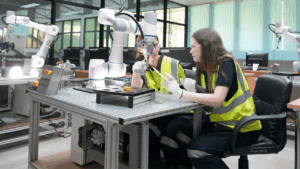Artificial Intelligence (AI) is rapidly transforming industries across the globe, and as its influence grows, so does its environmental impact. Enter Green AI—a movement aimed at reducing the carbon footprint associated with AI technologies while maximizing their positive contributions to our planet. For environmental professionals and activists, understanding and implementing Green AI can be a game-changer.
Understanding AI’s Carbon Footprint
AI systems, especially those leveraging deep learning, require substantial computational power, leading to increased energy consumption. According to a 2019 study by the Massachusetts Institute of Techonology, training a single AI model can emit as much CO2 as five cars in their lifetimes. This stark statistic highlights the urgent need to make AI more sustainable.
Green AI emphasizes optimizing these processes to reduce energy use. For instance, researchers from the Communications of the Association for Computing Machinery are developing algorithms that require less data and computational power or that can operate efficiently on renewable energy sources.
Major cloud providers such as Google, AWS, and Azure have made large commitments to reducing their carbon footprint through green technologies to achieve net zero emissions.
AI for Efficiency and Productivity
In today’s fast-paced world, there never seems to be enough time to get everything done. This is especially true for environmental professionals who have a myriad of tasks and responsibilities on their plate. However, with the help of AI-generated to-do lists, managing day-to-day tasks and prioritizing work can become much easier. By adopting Green AI, professionals can not only improve their productivity but also contribute to environmental sustainability.
AI-powered task management systems use algorithms that analyze a user’s workload, deadlines, and priorities to create personalized to-do lists. These lists are continually updated based on the completion of tasks and any changes in priorities or deadlines. By automating this process, environmental professionals can save valuable time and mental energy that would have otherwise been spent on organizing and prioritizing tasks.
Interesting Applications of AI for the Environment
AI is not just about efficiency; it’s also about innovation. Here are a few groundbreaking applications of AI in environmental conservation:
- Wildlife Conservation
In an exciting breakthrough for conservation, new pattern recognition software can make it possible to identify individual animals without physical tagging. For example, Wildlife.ai is working on multiple projects that track a variety of native species, such as Pepeketua frogs. This innovative tool uses advanced algorithms to recognize the distinct markings on each frog, allowing researchers to track individuals accurately and non-invasively over time.
- Climate Change Modeling
NASA and IBM’s new Prithvi Weather-Climate foundation model is making groundbreaking strides in weather and climate forecasting by analyzing vast datasets with unprecedented speed and accuracy. These models leverage machine learning to improve predictions of severe weather events, enhance long-term climate models, and refine our understanding of global atmospheric patterns.
Similarly, researchers at McMaster University are creating AI models to help Canadian cities predict severe weather events such as the 2013 Calgary flood. These technologies can empower governments and communities and educate them on the possible impacts of climate events.
- Smart Agriculture
According to a Forbes article, AI is revolutionizing agriculture with advanced innovations that boost productivity, sustainability, and resilience. From precision planting and harvesting to smart irrigation systems, AI-powered tools enable farmers to make data-driven decisions, optimizing resource use and reducing waste. Machine learning algorithms analyze soil health, predict crop yields, and even detect pest infestations early, empowering farmers to act proactively.
- Pollution Monitoring
An article from Hygiene and Environmental Health Advances explores the use of Artificial Intelligence (AI) in environmental monitoring provides precise disaster predictions, identifies pollution sources, and enables thorough assessments of air and water quality. AI-powered sensors and platforms monitor air and water quality in real-time, providing critical data that enhances environmental protection.
Career Development through Green AI
For environmental professionals, acquiring skills in Green AI represents an exciting opportunity for career advancement. The integration of AI into sustainability efforts not only enhances one’s technical capabilities but also positions individuals as leaders in a rapidly evolving field. By being at the forefront of Green AI, professionals can drive significant change and innovation in their organizations and beyond.
Whether you’re an early-career professional or a seasoned environmentalist, understanding and utilizing Green AI can open doors to new opportunities and initiatives, making your career both impactful and future-proof.
Green AI holds the promise of transforming the way we approach environmental challenges, making it an invaluable tool for environmental professionals. By reducing AI’s carbon footprint, automating data processes, and leveraging innovative applications, Green AI is setting the stage for a more sustainable future.
Check out these environmental organizations who are leveraging AI in their sustainability efforts:
- Wildlife Conservation Society Canada is applying AI for biodiversity tracking, using machine learning to recognize animals from sounds and images. This approach reduces the need for fieldwork, conserving fuel, resources, and time.
- SomaDetect based in Fredericton, has created a sensor that offers instant, real-time milk quality analysis without any use of harsh chemicals.
- Chrysalabs from Montreal created a soil sensing solution that measures soil health, providing farmers with real time data about the nutrient levels of their soil.
- Precision AI in Saskatchewan uses artificial intelligence for precise pesticide application, reducing chemical pesticide use by 95%
Investing in Green AI isn’t just beneficial for the environment—it’s a strategic move for any professional looking to expand their impact and career prospects in environmental science and policy.
ECO Canada recognizes the transformative power of AI in the environmental sector and offers a free comprehensive Artificial Intelligence (AI) Primer Course to equip you with essential AI knowledge and practical skills, empowering you to leverage AI in your daily operations to enhance efficiency and impact: https://staging.eco.ca/online-learning/artificial-intelligence-ai-primer-course/
In addition to taking the Artificial Intelligence (AI) Primer Course, immerse yourself in the dynamic world of artificial intelligence at ECO IMPACT 2025’s inaugural session; AI-empowered Sustainability: Forging the Future Workforce and Environment. Embrace the future of ECO IMPACT with a forward-thinking dialogue on how AI-enabled sustainability can positively influence the future of the environment.
Register today for ECO IMPACT and secure your spot at our AI learning opportunities: https://ecocanada.regfox.com/eco-impact-2025





